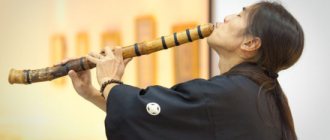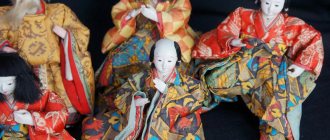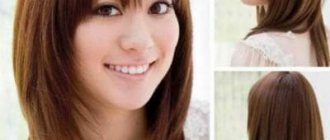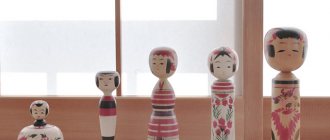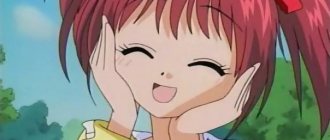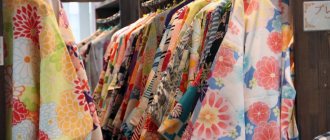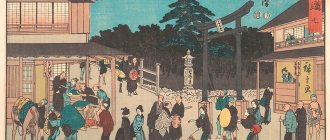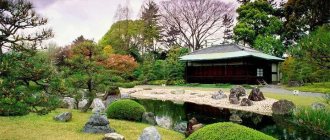The main thing
Dances in Japan are traditionally called “nihon bue”, but if you look at the etymology, this is not entirely true. “Bu” means the choreography of the Middle Ages in general, and “e” indicates belonging to the Edo period - the 18th century. That is, “buyo” is the dance of the Edo era, which is a type of dance part of the kabuki theater, although in modern times this word refers to Japanese dance performances in general.
Folk dances developed in conjunction with other forms of art - calligraphy, theater, literature, music - and, like them, they have features that are distinctive in Japanese and a little strange for a European. A combination of smooth and sharp gestures, clearly defined facial expressions, amazing costumes and bright makeup - Japanese dancers are equipped with all this.
However, for the most part, Japanese choreography does not accept “ragged” movements. All poses, called “kata”, are known in advance and honed to perfection. They have a slowness bordering on immobility: the body remains in one place most of the time, and only the hands, shoulders, and head change position in space.
The movements of the characters should seem to be gliding, so they dance either in a room with special tatami on the floor, or on an equipped stage. The composition is built according to a certain “jo-ha-kyu” model, which is also used in literature, theater, and even tea drinking. Its meaning is that all actions are sequential:
- dze - introduction to prepare the viewer, convey the atmosphere; lasts longer than other parts;
- ha – development of events containing a climax;
- kyu - unexpected outcome; the shortest part in duration.
The Japanese believe that choreography, along with calligraphy, ikebana and other types of decorative and applied arts, has a great effect on the cultural development of girls and the revelation of their feminine energy.
Japanese dance history
Dancing for the Japanese is not simple body movements. Each Japanese dance has its own history, its own symbolic movements. This is a kind of ritual into which the Japanese attach a certain meaning and give it a meaning that only they understand. Japanese dance is a magnificent theatrical performance. The dance often contains additional attributes.
The earliest archaeological evidence related to the performing arts in Japan dates back to the Yamato period (300-710 AD). Objects found by archaeologists include miniature tools, masks and jewelry, as well as clay figurines of dancers, which were called Haniwa sculptures. The traditions of the early dances that are still performed today, the so-called kagura dances, stem from this period.
Two kinds
There are two main types of national dances:
- May
Literally meaning “to rotate”, this concept points to its origins - women used to perform ritual dances in the temple, moving in a circle, while they held various plants. In this way they prayed to the deities to grant them a fertile and peaceful state.
A similar ritual became the basis for dance - peaceful, soft, restrained. It also served as the basis for a theatrical performance in the traditional Noh style. In this case, dancing with fans began to symbolize walking with plants.
- Odori
The term translates as “jump”, and this makes sense - in this dance the movements are sharp, as before a jump, rather rough and jerky. Initially, this appearance appeared as a result of the Jodo school of Buddhism, which included many peasants. Later, it gradually transformed into a separate art form - the kabuki theater, famous throughout the planet.
girls were hired as kabuki theater actors , but then a government decree was issued prohibiting the fair sex from playing in these theatrical productions. Then their place, even in the roles of women, was taken by men.
Traditional Japanese dances - an alluring secret of the east
Hello, dear readers – seekers of knowledge and truth!
Continuing the series of articles on the topic of Asian culture, it is worth talking in more detail about traditional Japanese dances. They are too different from the ones we are used to, they inevitably attract and raise questions. When did they appear, in what types, styles and schools do they exist, what is their peculiarity, what accessories do dancers use - we will learn about all this from the article below.
It will be interesting and informative!
Other varieties
Dancing in the Land of the Rising Sun appeared more than a millennium ago. In the first poetic anthologies “Nihongi” and “Kojiki” one can find legends telling about the solar deity Amaterasu. The goddess hid in a cave, but her attention was attracted by the dance movements of the deity Ama-no, and she looked out from the cover.
This species is called "kagura" and is considered the oldest in Japan. In addition, there are several other varieties of dance that have appeared over time:
- Mim-gigaku - borrowed from Chinese and Korean territories, thoroughly imbued with symbolism. The dancers, who were mostly men, dressed in colorful lion costumes and performed acrobatic feats. There are several variations, such as the samurai mime-gagaku.
- Furo is court choreography of the 12th-13th centuries, personifying an imperial conversation with a minister. In general, even little boys and girls could participate in dance performances at the palace.
- Surgaku - characterized by rhythm and expressiveness, is part of the performance accompanied by music.
- Kovakamai is a dance of three men to the accompaniment of a warlike choir and musical instruments: drums, pipes.
- Nembutsu is a ritual dance number performed in Buddhist monasteries on memorial days.
- Llomanzay - performed primarily on New Year's Day and is intended to pray for peace and good fortune in the coming year. A mandatory accessory is a fan, and the dancers depict birds, plants, and boats, which in itself is the personification of happiness.
- Sakura is a celebration of spring, sun, clear sky and sakura flowers. The choreographic steps are invariably performed by girls.
- Butoh is a modern look, sensual, full of expression. The performers are smeared with a thick layer of makeup and half naked, and the movements are designed to show the search for the meaning of life, inner emptiness.
All these and many other dances can be seen firsthand at the Awa Dance Festival, held annually in mid-August in the city of Shikoku.
Theater and dance in Japan
The myth of the origin of theater and dance dates back to the 8th century AD. According to this myth, the Sun Goddess was outraged by her brother's prank and locked herself in a cave, after which darkness fell over the whole world. The other gods gathered in front of the cave entrance to ask her to come out. The beautiful maiden Uzume, the goddess of the dawn, began to dance in front of the cave so wildly and passionately, as if spirits had possessed her. While dancing, she exposed her breasts and the other gods began to applaud and express their admiration so loudly that the Sun Goddess became curious. She decided to look out to see what was happening outside. After she saw the dance, the goddess no longer wanted to return to the cave. So, thanks to the dance, light and warmth returned to this world.
Buddhist ritual dances
Nara period: Japan's accession to international Buddhist culture
Thus, Nara became an integral part of international Buddhism in a cultural sphere that extended from China to Central Asia and on to India. This period is characterized by the flourishing of Buddhist mask dances, as well as various other dances that were adapted by the Nara imperial court, eventually forming the Bugaku, a traditional court dance that is still practiced today.
Japanese court dances
Japanese dances are a ritualistic and often incomprehensible spectacle for Western viewers. Strange movements of arms and legs, incomprehensible distorted facial expressions - once you see a real Japanese dance, it will be difficult to forget about it. The history of the creation of this truly unforgettable spectacle goes back hundreds of years.
Heian period, the emergence of a purely Japanese aesthetics
In 748, Emperor Kammu moved the capital from Nara to Heian-kyo (modern Kyoto). He decided to take such a step because he wanted to isolate himself from the growing influence of Buddhism. At that point, the Buddhist monastic order had accumulated too much wealth and political power.
During the Heian period (794-1192), distinctly Japanese types of culture emerged that no longer had much in common with China. New forms of art, poetry, literature and general aesthetics began to emerge. Even new beauty standards began to emerge. During the Heian period, the Buddhist mask dance of the gigaku virtually disappeared, and the court dances of the bugaku began to gain increasing popularity. New theatrical forms also developed based on earlier folk traditions, such as denkaku and sarugaku.
Feudal Period, Zen Buddhism, Samurai and Noh Theater
Japan's long feudal period was characterized by the emergence of a ruling class of samurai warriors. After a series of battles between feudal clans, Minamoto no Yoritomo was appointed shogun, who established his military government in Kamakura, despite the fact that Heian formally continued to maintain the status of the imperial capital.
New religions such as Chan Buddhism were borrowed from China. Chan Buddhism soon evolved into Zen Buddhism in Japan. It was Zen Buddhism that became the religion of the samurai in the 15th and 16th centuries, and it left a very strong imprint on Japanese arts, including theater. Zen artists and dancers strive to present their art through the simplest means available, and to convey the inherent natural beauty and aesthetics of each object.
Zen Buddhism became the main religion in Japan during the 15th and 16th centuries, having a significant influence on all Japanese arts, including dance and theater.
The minimalist aesthetic of Zen influenced the austere splendor of Noh theater, which developed during the Muromachi period (1333-1568). During this time, the capital was moved from Kamakura back to Kyoto. Noh, originally patronized by monks and samurai, has retained its essence, characteristics, acting and music to this day, and is now regarded as one of the greatest traditions of world drama.
Edo period, emergence of the urban middle class
The period from the mid-15th century to the early 17th century was marred by constant wars between the ruling clans. In 1600, Tokugawa Ieyasu defeated his rivals and established the Tokugawa shogunate in Edo (modern Tokyo). Thus began the Edo period (1600-1868), which was marked by a long era of political unity.
During this period, a new middle class emerged - merchants, who were no longer constrained by Zen philosophy or the strict code of ethics of the samurai. The new audience, city dwellers, wanted new entertainment. As a result, two notable forms of theater emerged: Bunraku puppet theater and a then-sensational form of kabuki, erotic kabuki, which was originally performed in mini-theaters located in the red-light districts of growing cities.
Westernization of Japan
After the signing of the Treaty of Kanagawa with the United States in 1854, Japan partially opened up to the outside world. By adopting Western political, legal, and military institutions, Japan adopted the Meiji Constitution. During the following Meiji period (1868-1912), the Japanese Empire was transformed into an industrialized country. Then the country began military operations to expand its sphere of influence.
The new rules gave rise to satirical plays, which were later transformed into melodramas. Gradually, Western theater, with its stage aesthetics and dramaturgy, was adapted to Japanese culture. A new type of theater, shingkeki or "new drama" also emerged under Western influence.
Schools
In modern Japan, there are various dance schools, and choreography has always been part of the geisha training program. Here there is the so-called “iemomoto” methodology, where the head of the institution is a professional person who selects a curriculum for teachers, issues licenses, and draws up a composition. He also chooses the necessary accessories - a fan, sword, umbrella, headdress or mask.
Japanese who begin training and achieve a good level of skill can still devote the rest of their lives to honing their skills. If we talk about the names of specific schools related to the direction, then the main ones include Fujima-ryu, Nakamura, Bando, Iwada, Nishikawa and many others.
Kagura, Shinto sacred dances
In Japan, as we know, archaic traditions often flourish. Kagura (divine performance) is one such dance tradition that is associated with Japan's first belief system, Shinto. Originally a strict formal art form, Kagura dance has undergone many changes over the course of a thousand years. Some of the dance forms are still associated with Shinto sacred rites and some with court practice, while other dance forms are associated with the agricultural calendar. Some forms of kagura use masks, while other forms that are more theatrical in nature involve telling stories and dramatizing stories.
Japanese dance styles
There are two main directions in Japanese dance: mai and odori. The movements in the performances of the Mai category are calm and smooth, and the main attention is paid to the gestures of the dancers, and odori is characterized by its impetuosity and special musical accompaniment. Dances of the Mai direction were performed during rituals, and in odori, with the help of gestures and movements, a certain performance was played out: the life of ordinary people and natural phenomena were told.
Many dance movements come from ancient rituals that were performed to summon the souls of the dead or to change the weather. Such dances have long been known to all residents and are considered traditional; they remain practically unchanged for many years. It was only in the 20th century that Japanese dance culture underwent innovations and completely new movements appeared.
Famous dances[ | ]
Gion kouta[ | ]
Maiko dance Gion koutu Lyrics to music appeared in 1930, their author is Mikihiko Nagata (Japanese) Russian. - a famous writer who created lyrics for numerous songs about Gion. He also wrote the lyrics to the songs in the film “Geisha”.
| Japanese text | Transcription | Translation |
| 月はおぼろに東山 | tsuki wa oboro ni higashiyama | The moon is hazy over Higashiyama, |
| 霞む夜毎のかがり火に | kasumu yogoto no kagaribi ni | Every night by torchlight through the fog |
| 夢もいざよう紅桜 | yume mo izayo benizakura | Scarlet sakura invites you to dream. |
| しのぶ思いを振袖に | shinobu omoi o furisode ni | I remember furisode with sadness |
| 祇園恋しや だらりの帯よ | gion koishiya darari no obi yo | And Gion’s beloved fluttering obi. |
| 夏は河原の夕涼み | natsu wa kawara no yu: suzumi | Summer. Enjoying the coolness of the night. |
| 白い襟あしぼんぼりに | Shiroi Eriashi Bombori ni | Bombori on a white neck |
| かくす涙の口紅も | kasugu namida no cutibeni mo | Red lipstick and invisible tears. |
| 燃えて身をやく大文字 | moete mi o yaku daimonji | I'm burning like a daimonji : |
| 祇園恋しや だらりの帯よ | gion koishiya darari no obi yo | Beloved by Gion darari-obi! |
| 鴨の河原の水やせて | Kamo no Kawara no Mizuyasete | A cool wind blows in the dry riverbed of Kamo. |
| 咽ぶ瀬音に鐘の声 | musebu seoto ni kane no koe | The voice of a bell can be heard in the choking sound. |
| 枯れた柳に秋風が | kareta yanagi ni akikaze ga | Autumn wind in the branches of a dried willow |
| 泣くよ今宵も夜もすがら | nakuyo koy mo yo mo sugara | Sobbing! And this evening it also fades. |
| 祇園恋しや だらりの帯よ | gion koishiya darari no obi yo | Beloved by Gion darari-obi! |
| 雪はしとしとまる窓に | yuki wa shitoshitomaru mado ni | Snow gently falls on the round window. |
| つもる逢うせの差向い | Tsumoru o o: se no sashimukai | Enjoy the secret meeting |
| 灯影つめたく小夜ふけて | Hokage Tsumetaku Sayo Fukete | I'm cold even by the fire. And the night gets dark. |
| もやい枕に川千鳥 | moyai makura ni kawatidori | Plovers sit on the mooring bollard. |
| 祇園恋しや だらりの帯よ | gion koishiya darari no obi yo | Beloved by Gion darari-obi! |
Kurokami[ | ]
Geisha Mamehiro performs Kurokami There are two versions of the Kurokami dance (Japanese 黒髪, black hair): jiuta style and nagauta style. The music and lyrics were probably originally written in the jiuta style by composer Ichijuro Koide (湖出市十郎koide ichijuro:
). However, his earliest recording is in the nagauta genre. In 1784, “Kurokami” was included in the performance of O-akinai Hiru ga Winter (Japanese: 大商蛭小島, grandiose fun in winter).
In the performance "Kurokami" is performed by Tatsu-hime (Japanese 辰姫, "Princess Tatsu"), the daughter of the commander Ito no Suketiki (Japanese 伊東祐親ito: no suketika
), when Minamoto no Yoritomo breaks her heart by choosing Masako Hojo over her (Japanese: 北条政子ho:jo: masako
).
The dance is performed by a soloist with a folding fan "sensu". In the Japanese poetic tradition, jet-black hair is considered a symbol of female beauty, and the unraveling of a traditional hairstyle, where the hair was raised high and secured, is a clear hint that the heroine has ceased to control herself.
